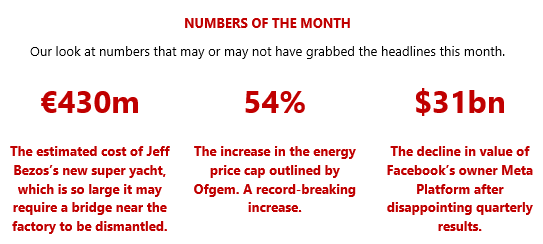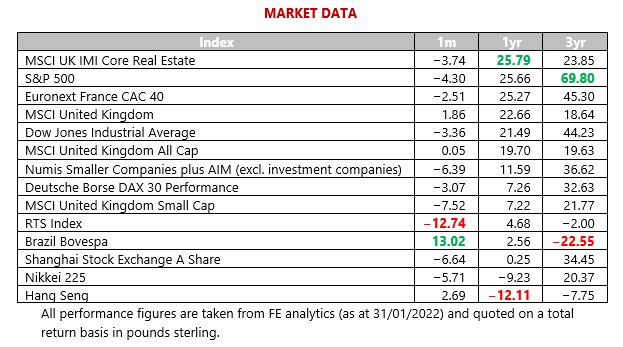United Kingdom - February 2022
Our theme this month is the welfare state. The welfare state is considered to be ‘a concept of government in which the state (sometimes a well-established network of social institutions) plays a key role in the protection and promotion of the economic and social well-being of the people’. In the UK, the welfare state is generally considered to have been created by the Labour government after WWII, following the recommendations of Sir William Beveridge, who aimed to ‘wipe out poverty and hardship in society’.
It is easy to stick to this narrative, but in fact the beginnings of what we see as the welfare state today probably go all the way back to the Royal Commission into the Operation of the Poor Law in 1832, which found that the old Poor Law was subject to widespread abuse; it ‘promoted squalor, idleness and criminality in its recipients’, compared to those who received ‘private charity’.
A minimum wage was originally introduced in 1909. The NHS was launched in 1948 and involved no new hospitals, just the nationalisation of what already existed (and had been unaffordable for too many). Both Labour and Conservative governments played a part in the development of the welfare state over the following few years.
Today, the idea that the protection and promotion of the economic and social wellbeing (can we throw in environment?) is important doesn’t just exist in the welfare state (and many would argue some areas have changed immeasurably); it is part and parcel of various movements from #MeToo to #BLM, and in our world ‘ESG’ (environmental, social and governance issues).
We need to cover the issue of rising UK inflation. We have highlighted before that the Bank of England doesn’t have a great record in its inflation outlook, but this time, it is perhaps understandable that it hasn’t, until very recently, expected inflation to get to where it is (and before long, beyond). The use of interest rates is the most traditional weapon for the Bank of England, yet, as you will read later, the impact surely will be minimal this calendar year. The threat of rising rates carries some weight, and we have seen that threat weigh on a number of sectors, especially in the US where the Federal Reserve (Fed) faces a similar issue.
Longer duration growth sectors like tech and healthcare, plus some of the environmental assets like clean energy and even some listed infrastructure assets have borne the brunt, while one of the original sin sectors, oil and gas, is having its day in the (ironically) hydrogen dominated sun.
We said just a month ago ‘For the coming year, we do see challenges, and we do recognise how well paid investors have been in the last two years … having different assets that do different things in different conditions is a vital part of a good plan, and we never take a binary approach to any single risk in portfolios’. January certainly delivered in that respect, with many previous sweethearts being, if not dumped, then given the cold shoulder, even as we approach Valentine’s Day. A lot less love around and many reverting to the (ironically) old flames of oil, gas and other industrials. We will be sticking with our long-term thematic approach and are looking to develop that further.
Term or word(s) to watch: Sagana Lodge – probably not on the tip of everyone’s tongues, this, like plenty of other unknown locations, saw the start of a multi-decade success story. Where did Microsoft start, what about Amazon et al? Sagana Lodge was where Princess Elizabeth found that she was Queen Elizabeth II, and yesterday (6 February) saw her 70th anniversary as monarch. Let’s hope all the plans for a spectacular Platinum Jubilee can go ahead this year.
North America - February 2022
As elsewhere, January began with a bang with the US leading equity markets down as opposed to up as it had done seemingly forever. In mid-January, the S&P 500 hit correction territory having given up 10% from its high, while the NASDAQ has been battered by the drastic shift away from speculative technology names (note, not all tech has been hit as hard). The main spur for these developments has been the more hawkish stance adopted by the Fed with recent comments suggesting that we may see four rate hikes this year in response to what seems less than transitory inflation.
Some analysts are now expecting as many as six to come through over the next 12 months. In addition, the Fed will be winding down its asset purchase programme and also reducing the size of its balance sheet. This will put pressure on Treasuries but is also a very dangerous environment for equities, and volatility has duly picked up. Sentiment has also been impacted by the idiosyncratic risk posed by the situation developing between the Ukraine and Russia.
Those growth names that have been the greatest beneficiaries of low interest rates have been the most impacted and other speculative assets offering no yield/cash flows such as Bitcoin and other cryptocurrencies have been hit hard. Value has continued to show signs of outperformance, though a sustained fall in risk assets would do these stocks no favours either.
Still, many will choose to increase exposure to the financials, energy and industrials sectors as a response to what looks like a proper rate hiking cycle.
The welfare state provision in the US is regarded as relatively undeveloped for an advanced country, certainly compared to those nations in Europe that have followed more social democratic models. The founding legislation in this regard was the Social Security Act of 1935, which was introduced as part of Roosevelt’s New Deal and established social security and a modest system of insurance against unemployment.
The post Covid-19 landscape looks encouraging enough with the occasional worrisome data point. Some are concerned that rates will tighten to such a degree that they will induce a recession – clearly an effective way of tackling inflation but another reason to be cautious entering this new phase in the cycle – if indeed that is what it turns out to be. Our US exposure is nicely blended style wise (where it is found in geographically focused US funds) with the majority achieved through thematic vehicles.
Europe - February 2022
As with other major markets, inflation remains a focus in Europe. Data from Germany, Spain and France shows January inflation figures staying higher than many expected. German year-on-year CPI inflation was down from 5.3% in December to 4.9%, as compiled by the Federal Statistical Office (Destatis). Spanish inflation fell from 6.5% to 6.0%, as compiled by the Instituto Nacional de Estadística. Provisional data from the INSEE statistics agency data in France revealed a 2.9% 12-month CPI inflation figure, up from 2.8% in December.
These different agencies use slightly different methods for their domestic statistics, with a harmonised index of consumer prices (HCPI) more useful for comparison and eurozone level data.
Looking beyond the nuances in these methods, the figures have many similarities and, very generally, while prices for manufactured goods have fallen, the majority of other prices have still been increasing. This includes services, where many businesses have opted to increase prices to make up for lost revenue during the pandemic. Food prices have also been rising.
Energy prices also remain a significant part of inflation, with year-on-year energy prices up 20.5% in Germany and 19.7% in France. In the short term geopolitical concerns may impact this element further, particularly if the supply of gas from Russia is sanctioned or weaponised as part of the ongoing tensions over Ukraine (we cover this in more detail in the Emerging Markets section of this commentary).
For the European Central Bank (ECB), these higher readings have increased calls for interest rate rises, which so far have been resisted.
ECB President Christine Lagarde has stated that increasing rates too quickly would risk ‘putting the brakes on growth’ and that given Europe is earlier in its recovery than the US it does not need to act as aggressively just yet.
Inflation remains higher and increases pressure on the ECB to raise rates, which might slow the pace of the European recovery. Geopolitical tensions (Russia) and any re-emergence of Covid-19 – including any global supply chain impact if China is hit – remain a threat to European economies. We still see better relative value in European equities, especially against more highly rated US names.
Japan - February 2022
Japanese markets were largely shunned during 2021 with Japan equity funds seeing outflows of approximately 9 billion yen (£58 million) over the year. Although the main Japanese equity market did end 2021 in positive territory, the journey was anything but smooth with a number of peaks and troughs over the year. Overall, the 2021 performance paled in comparison to an excellent 2020 when it outpaced even the US S&P 500. The majority of asset classes endured a tough January and Japan was no exception with the TOPIX down c. 4% in sterling terms.
We do not expect the recent price volatility to dissipate quickly but instead anticipate market gyrations to continue over the short term. Japanese markets tend to be driven by currency movements with a weaker yen recently propping up the equity market. The response to the Covid-19 variant Omicron will be key over the first quarter.
The recent outbreak remains a source of uncertainty that could delay domestic reopening, as Japan faces a sixth wave with over 50,000 Omicron cases a day over the second to last weekend in January.
Looking through this short-term noise though, we think there are fundamental reasons to be positive on the area. We see signs that investors’ interest has been piqued by the region as stronger corporate governance contributes to improved earnings prospects, and the semiconductor industry continues to be in focus. Although the country got off to a relatively slow start in terms of its vaccination programme, administration of the third dose of the Covid-19 vaccines was well underway by December.
In Japan, 65% of the elderly live with their children, and the typical household is composed of three generations. This is because Japan’s welfare state embodies familialism, whereby families rather than the government will provide the social safety net.
We also saw sentiment among Japan’s manufacturers rise to a four-month high recently and while inflation is a headache for much of the world, inflationary pressures could be a welcome surprise for the region, which has been dogged by deflation for many years.
Overall, Japanese equities are one of the least held assets by global investors, but we see plenty of reasons to buck this trend. Indeed, should we see flows into the region this could have a huge impact on asset prices and may surprise investors, taking the market in a positive direction.
We remain overweight to Japanese equities versus our peers, believing that reforms over the past few years and positive changes in corporate governance have led to better fundamentals than most recognise.
Asia Pacific - February 2022
In January, the UK launched trade talks with India in the hope of a post-Brexit free trade deal. India is the biggest country with which the UK has tried to strike a deal since departing the EU and there are a range of topics on the table. From an Indian perspective, easier visa access for students and skilled workers and better market access to agricultural products are key objectives. The UK wants a reduction on tariffs in relation to whisky, cars and wind turbines.
The UK has a long and complicated history with India, but they remain valuable trading partners with £18.5bn of trade completed in 2020. The aim is to more than double this to £50bn by 2030. However, India has proved a difficult country with which to strike up trading relationships in the past, with many such proposals failing due to opposition from concerned domestic firms.
Relations between the UK and India were boosted last year, when the government u-turned on controversial tax laws that led to disputes with several large UK firms, the most well publicised being Cairn Energy and Vodafone. Perhaps India has realised that it needs better trading relationships to meet its own goals, particularly in relation to the energy transition, with Prime Minister Narendra Modi pledging that 50% of India’s energy will come from non-fossil fuels by 2030.
Thus far, high taxes on battery imports have been prohibitive in building the energy storage infrastructure that the country needs. The country has been keen to build its own domestic battery manufacturing capabilities, but with this likely to take some years to be truly competitive, there is a real risk that the country could start to fall behind on its environmental targets. A more open-minded approach to trade may be the only option.
One of the earliest examples of a welfare state was put forward by Emperor Ashoka of India in the 3rd century BCE. Some sources claim he declared ‘all men are my children’ and renounced war and the killing of many animals. His idea was to conquer the world through love and faith … not dissimilar to the hippy movement of the 1960s!
We remain excited by the opportunity India presents and believe that we have exposure to a range of equities that can benefit from the domestic growth story.
Emerging Markets - February 2022
After its stellar year in 2021, Russia has gone into reverse over January. You would have to have experienced a total news blackout to not be aware of the reasons for this. The possible invasion of the Ukraine by Russia has created serious alarm among the leaders of Western countries and investors have started to mark down Russian assets.
The real fear of course is that the response to any military intervention will see overwhelming sanctions imposed by the US and others, which will devastate the Russian economy and hit asset prices. Both equities and bonds have already seen significant drawdowns, and this highlights how, in times of acute stress, investors will flee emerging market countries more readily than developed ones. True this is an exceptional situation, but still there is undoubtedly more vulnerability to crises.
More generally, investors seem to be weighing up the attractive valuations that are seemingly available in many emerging markets with the obvious headwinds created by a US rate hiking cycle. Periods of significant sell-offs in the US market are unhelpful for bolstering sentiment more generally and any shift lower in US valuations diminishes the relative valuation argument for other markets.
We have been reducing our China exposure in most portfolios and the lack of transparency in that market remains a major concern. Again, this sort of loss of faith in the largest emerging market does not inspire confidence among emerging market investors in general, though some will clearly move more funds into China hoping for a swift recovery.
The events in the Ukraine will also serve as a reminder of geopolitical events more broadly, with minds naturally wandering to the possible sources of conflict involving China, such as Taiwan and developments in the South China Sea. The importance of such flashpoints can often be exaggerated in investors’ minds, but we are occasionally reminded that they can be of real consequence.
If we want an example of a truly developed welfare state, look to Cuba. Food subsidies and provision form part of citizen entitlement in the country despite numerous suggestions that reform is necessary. A large percentage of the population still relies on a centralised distribution system for their food, called the Libreta de Abastecimiento.
Much of the emerging markets space looks challenged but there is enough potential in India and other, select areas to merit some continuing involvement.
Spotlight on: Infrastructure - February 2022
This month’s spotlight section focuses on infrastructure, an area that is often in the headlines whether it be talk of ‘levelling up’ or ‘Building Back Better’. Improving infrastructure is one of the few areas that cross political divides in both the UK and the US, being near universally popular with most voters (other than those who have ‘not in my backyard’ objections at local level).
We even saw rare bipartisanship when the US passed the Bipartisan Infrastructure Bill in November 2021, seeing $1.2 trillion committed. Infrastructure is also likely to continue to be strongly supported given environmental targets, with new infrastructure needed for electric vehicles both on road networks and the electricity grid.
Infrastructure can be invested in directly or indirectly. Indirect investment includes investing in construction companies or raw materials, with aggregate (gravels, sands) and concrete companies a way to play both. Direct investment into infrastructure also has many forms, often with different risk and return characteristics.
The least risky are availability-based assets, which include schools and hospitals, where contracts are paid as long as the assets are available regardless of whether they are used or not. This differs from user-pays assets, such as airports and toll roads, where the returns are linked to the number of users, making these more economically sensitive.
Many of these areas saw revenues fall during the pandemic as more people worked from home. The final type is regulated returns, which includes utilities such as water or electric providers. As the name suggests, the regulator sets the level of return and charges that can be achieved, which is designed to stop excessive profiteering off essential services and also to encourage maintenance and new investments.
We have exposure to infrastructure within our real assets allocations in most portfolios, with defensive portfolios including more availability-based assets and higher risk portfolios having more exposure to regulated and user-pays assets.
Fixed Income - February 2022
Investors in European fixed income have had it easy for a long time now; in fact many had probably become complacent. Years of quantitative easing and ultra-low, indeed negative, interest rates had help to drive yields to record lows. Even with a record inflation print, many have been surprised by the hawkish overtures from the ECB.
At the start of February, ECB President, Christine Lagarde declined to rule out raising interest rates to combat the 5.1% inflation figure.
With so much of the eurozone inflation coming from energy prices and geo-political factors rather than being demand driven, it is no wonder investors were caught off guard. Goldman Sachs now anticipates the ECB will end their asset purchase programme in June and then attempt to raise interest rates by 25bps in September and again in December. This path would mean that European interest rates would end 2022 at 0%.
The comments, or lack thereof, sent yields on sovereign debt for those with the lowest ratings spiralling. Indeed, the spread between Italian and German 10-year bond yields spiked to its widest level since the pandemic hit in 2020 (150bps). The next meeting in March should provide a much clearer timeline. However, with half of eurozone inflation coming from energy prices, the ECB’s decision is somewhat contingent on the situation in Ukraine.
Social impact bonds can be used to support the wider welfare state. In 2010, Peterborough Prison issued one of the world’s first social impact bonds and raised £5m to fund a pilot project designed to reduce reoffending rates. The return was directly linked to reconviction rates over an eight-year period.
As a reminder, the last time the ECB raised interest rates was just as the eurozone debt crisis began in 2011. Though Christine Lagarde has insisted that the ECB has learned from that particular episode, it will surely play on the minds of central bankers. We retain our cautious stance on fixed income, with relatively low levels of duration to mitigate the risk of sustained rate rises.
Commodities - February 2022
Many commodities have enjoyed a strong start to the new year, enjoying fortunes wildly divergent from those of most equities. Clearly each commodity has its own set of distinct drivers, but the moves have been pretty widespread. Aluminium and lithium have continued to climb to sit at multi-year highs with oil also delivering more gains. Some analysts are now suggesting that oil could comfortably reach $100 a barrel as supply side issues are complicated by the transition to green energy.
Pleasingly, gold and silver have also shown signs of life having disappointed many of late. Those partial to excitability are now talking of a new commodity super cycle being underway, which is plausible, though others suggest that some of the driving forces are transitory (there’s that word again) and a weakening of the global economy from current levels could clearly be a headwind.
Still, it is true that capital that would have gone into natural resources investment has been diverted elsewhere over the last decade and supply pressures would seem to be an inevitable consequence.
You would have thought commodities might feature more heavily in investor portfolios given the hedging and inflation protection characteristics they offer, but most investors have relatively little. If investors are looking for somewhere to hide from interest rate hikes, this might be an important area, as the scarcity attraction can persist while other areas get marked down. Some of the ESG names are vulnerable to higher rates and commodities might just prove an interesting hedge in this regard.
The case for a broader commodities exposure is arguably the strongest it has been for some time, and we continue to look at the space with renewed focus. This said, accessing the right kind of vehicle in such a differentiated space is not especially straightforward and betting on the direction of individual commodities is best avoided. For now, we are holding firm with our gold and silver exposure in addition to some strategic metals holdings for the more adventurous.
Property - February 2022
Those who are fortunate enough to own a property will have been through the arduous process of dealing with estate agents, solicitors, mortgage brokers and those within ‘the chain’. Research of Land Registry data by estate agent comparison site, GetAgent.co.uk, revealed that the average selling time for a property is now around 295 days. Delays caused by the stamp duty holiday and the pandemic have seen this increase by around 43 days, but even the pre-pandemic number is pretty staggering.
In a society now accustomed to next day delivery and ever increasing levels of convenience, it is remarkable that we are so accepting of this long drawn-out process. Since 2010, several entities (including the Land Registry itself) have tried and failed to modernise the conveyancing process. The latest challenger is pinning its hopes on blockchain technology to connect to existing systems used by conveyancing firms.
At its simplest, blockchain technology (often synonymous with crypto currencies) is a distributed database that stores information electronically across a computer network. In this instance, the aim is to allow data, documents and live updates to be shared real time, without the need for a single standalone piece of software.
The results so far are positive, with integration completed with the most popular case management system.
Like so many things, success depends on widespread adoption and it will be interesting to see how things progress. At present, around 34% of property transactions fall through and the hope is that this number will decrease as the process streamlines and the sharing of data is improved through the integration of blockchain technology.
Our property exposure continues to be achieved through expert managers … thankfully, this means we do not have to endure the buying and selling process ourselves. NB, we also major on commercial rather than residential property in portfolios.
Responsible Assets - February 2022
As regular readers will know, there are three key parts to ESG. These are environmental, social and governance issues. All too often we and others are guilty of focusing most of our attention on the environment. Governance is the framework used to manage an organisation. No, it is not particularly glamourous or exciting, but it is vitally important and also provides a solid base for environmental and social activities.
One area of governance that is attracting more attention, and rightly so, is the representation of women on boards. While we would hope that all members would be elected to the board of directors on merit, it is hard to believe that this is the case, given the under-representation of women.
Ensuring proper female representation isn’t just about ‘doing the right thing’; it also makes business sense. Many studies have shown that board diversity is good for business. In 2009, a study in the Harvard Business Review showed that when Fortune 500 companies were ranked by the number of women directors on their boards, those in the highest quartile reported a 42% greater return on sales and a 53% higher return on equity than the rest.
Board representation varies significantly, by role, industry and region. Despite various firms in the sector being embroiled in sexism scandals, the technology sector is generally one of the best when it comes to female representation, with financial services and manufacturing not far behind.
In terms of regions, it is the Nordics that lead the way (percentage number of seats held by women), with Asia lagging quite severely. The likes of South Korea and Japan are notable laggards and cultural differences may mean that bridging the gap may take some time.
Board composition is just one factor that we expect our fund managers to consider as part of their ESG analysis. While the direction of travel is good, more needs to be done.
Currency - February 2022
Why might the US dollar strengthen and does it matter to UK-based investors? The prospect of higher interest rates tends to suck in speculative, short-term money flows from overseas. In recent weeks we have seen US interest rate forecasts rise faster than for those of other major economies, in response to 7% inflation.
The futures market is pricing in a 1% Fed funds rate by the end of December 2022, from just above zero today, leading to speculation of a stronger dollar. Sterling has become less politically sensitive over the last year, but a period of government drift could put renewed downward pressure on the currency, accentuating the impact of a strong dollar for a UK-based investor.
A strong dollar will be positive for large dollar-earnings multinationals on the London main market, thanks to the currency translation effect. It should also support exports to the US and to those countries who tie (or peg) their currencies to the dollar. A weak dollar also has an impact – we will look at that next month.
UK Interest Rates - February 2022
What’s next? A second base rate rise in succession, yet still the level is a mere 0.5%, even as inflation (by the Bank’s own forecasts) heads to (and almost certainly beyond) 7%. How can the former realistically impact the latter? Well, the answer is, it can’t, not to any meaningful degree.
Just last week, Deputy Governor Ben Broadbent told us that ‘it doesn’t matter what causes inflation, one has to act regardless of the source’ – and yet the Bank still maintains that realistically any rate rise can take 12 to 18 months to have an impact. We know one of the major issues (energy inflation), but it isn’t the only one, and we may now expect more Bank activity in a calendar year than at any time since 2008.


The Monthly Market Commentary (MMC) is written and researched by Simon Gibson, Richard Smith, Scott Bradshaw, Jonathon Marchant and Lauren Wilson for clients and professional connections of Mattioli Woods, and is for information purposes only. It is not intended to be an invitation to buy, or to act upon the comments made, and all investment decisions should be taken with advice, given appropriate knowledge of the investor’s circumstances. The value of investments and the income from them can fall as well as rise and investors may not get back the full amount invested. Past performance is not a guide to the future. Mattioli Woods is authorised and regulated by the Financial Conduct Authority.
The MMC will always be sent to you by the seventh working day of each month, usually sooner, is normally delivered via email, and is free of charge as the MMC is generally made available to clients who have assets under our management in excess of £200,000, and to all clients under our Discretionary Portfolio Management Service (DPM). Normally, the MMC costs £397 + VAT per annum. Professional advisers and their clients should contact us if they are interested in receiving a monthly copy.
Sources:
www.bbc.co.uk,
www.bloomberg.com,
Financial Express,
www.thedragonsblade.com,
www.express.co.uk,
www.pitstoppin.co.uk,
www.sibcyclinenews.com,
www.vr-12.com,
www.smalltalkbigresults.wordpress.com,
www.anonw.wordpress.com
www.avantida.com,
www.plazmedia.com,
www.viewzone.com,
www.mmn.com.
All other sources quoted if used directly; except fund managers who will be left anonymous; otherwise, this is the work of Mattioli Woods.





